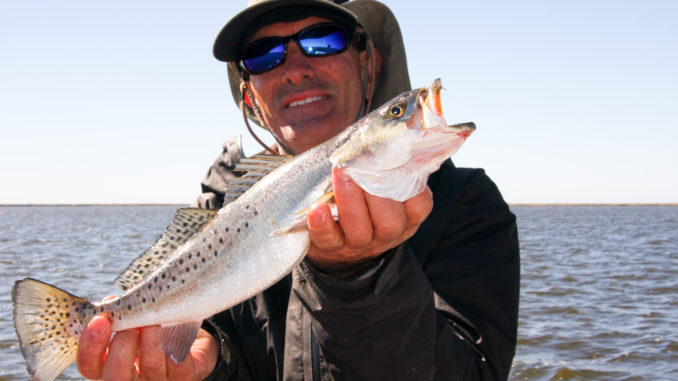
The rut is winding down as bucks come out of overdrive and gradually return to familiar ground. Yet, with shades of testosterone remaining and an occasional female cycling into estrus, a handful of deer are still engaged to procreate.
The trout bite along coastal Louisiana completely died after our record cold weather a couple of weeks ago. If anybody was catching any trout, they definitely weren’t talking about it or posting reports. That all started to change this past week, however, and the bite is starting to pick up in some places – and drifting seems like the best way to fill your box.
“Drift fishing is a really good way to catch trout when they aren’t just tearing it up,” said Capt. Frank Moore with Fishing With The King. “You got to think they’ve been laying around not eating much. Now that they’re hungry again they wake up and find that the bait’s all scattered out.”
Because the bait is scattered, Moore says the large schools of trout tend to break up into smaller packs of just a few fish that roam around the shallow bays later in the day looking for something to eat. They don’t stay in any one spot very long, so staying on the move is the key to getting bites.
Moore showed me his drift-fishing technique recently, although drifting is more of a process than it is a technique. As he shut down his motor on the lee side of Lake Ameda near Hopedale Lagoon, there were already several boats at varying stages of their drifts. Moore positioned his boat on a line that the wind would blow us across, and he kept one finger close to his Power Pole deploy button.
“I call it drift, stick and move,” Moore continued. “I set up on a drift and move until I get a few bites. Then I stick my Power Pole and fish until we go five to 10 minutes without a bite. Then I pick up my pole and move again. If you can pick up five to eight fish a pass, you’re doing pretty good.”
As we completed our first drift, Moore idled back to start another drift; only he didn’t go all the way to the lee shore this time. Rather, he started off the bank where we picked up our first bites. He reasoned that he didn’t want to drift an area again that wasn’t productive. However, Moore insists that nothing about drift fishing is written in stone.
“The fish don’t stack up in any one spot, so you’ve just got to keep fishing back and forth,” he said. “Maybe expand your drifts out from your first one to see if you can get on some more fish. When you get a few bites, stick up and catch them while you can.”
This time of year, Moore likes to fish small soft plastics under popping corks while he drifts. He understands big trout eat big baits, but he believes during the winter in the marsh, the bigger the bait the fewer the bites.
“They won’t hit a really big bait this time of year,” Moore concluded. “They like to eat baits that are the same size as what they’re used to feeding on. Things that look strange or different, they don’t eat as fast. And this time of year any fish that makes the party is a good fish.”
Editor’s Note: Contact Capt. Frank Moore and Fishing With the King at 504.881.9966, 504.887.4960 or visit www.fishwiththeking.com.


